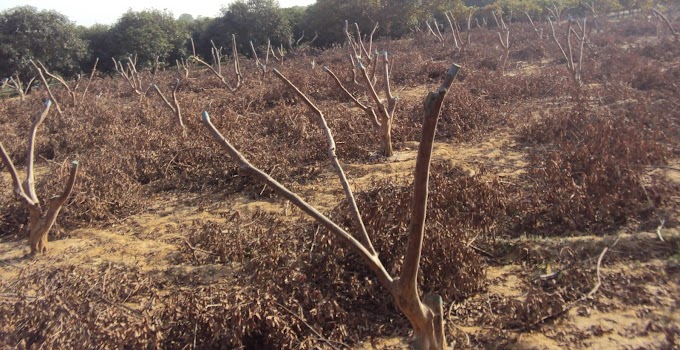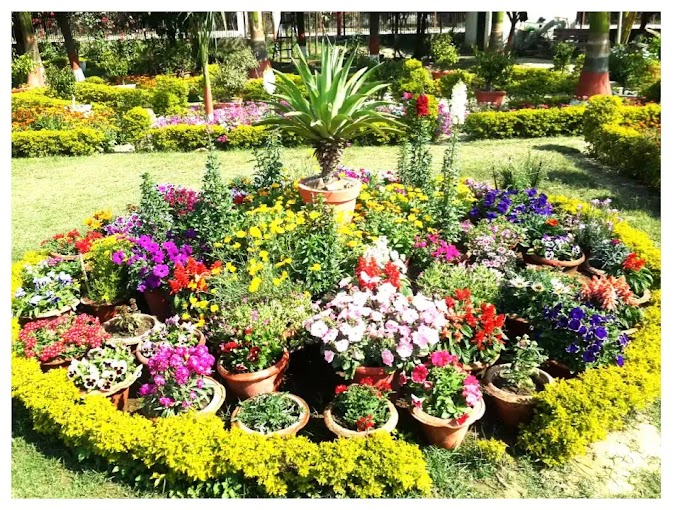D(caps)isease is an abnormal condition of plants caused by phytopathogenic organisms. A causal organism involved in development of disease in the plants.
Apple Scab
Apple Scab is caused by fungus Venturia inaequalis (Cke.) Wint. that attacks on foliage, blossom, young shoots, buds and fruits of apple. The velvety brown to olive green lesions appear on the affected parts of the plants. Attack of fungus on petioles and pedicels results in premature dropping of the leaves and fruits. The fungus survives on affected fallen leaves of apple during winter when winter overcomes and temperature increases the spores start germination on young leaves and fruits. The fungus enters into the saprophytic phase after leaves fall in autumn to overcome the winter. The 7-8 protective sprays of non-systematic and systemic fungicides during the growing season prevents the scab. After symptom appearance Carbendazim (0.05%) or Thiophanate Methyl (0.05%) should be sprayed thrice at 7-10 days’ interval to control the scab. Scab resistant cultivars such as Priscilla, Sir Prize, Macfree, Freedom, Coop-12, Coop-13, Firdous and Shireen should be preferred for cultivation.
Powdery mildew of apple
It is a serious disease of apples all over the world which is caused by fungus Podosphaera leucotricha (Ell. & Ev.) Salm. The small greyish or white patches appear on the under surface of leaves and later on entire leaves are covered with mycelium and powdery mass of spores. The causal organism survives into dormant buds in mycelial form during winter. The fungus becomes active in early spring and produces disease symptoms. The 3-4 spraying of fungicides like Carbendazim (0.05%), Thiophanate Methyl (0.05%), Dinocap (0.10%), Bitertarnol (0.10%) at 7-14 days’ interval from the pink bud stage control the disease.
Root rot in apple
The root rot is a serious problem of apples in Himachal Pradesh and Uttarakhand. The fungus Dematophora necatrix attacks on the roots particularly in the rainy season resulting in the death of apple trees. The leaves of affected plants turn into yellow and bronze colour and fall aw well as bark raptures. The disease leads to die back and ultimately plants die. New roots got infected through contact of infected soil, water and roots. To prevent the disease attack, the pits should be treated with 3% Formaldehyde 3 weeks before the planting. The disease can be effectively controlled by soil drenching under the canopy of plants with Carbendazim 50 WP (0.1%) or Mancozeb+ Carbendazim 75 WP (0.5%) during the rainy season. The Trichoderma viridae and T. herzianum are antagonistic to fungus D. necatrix; these antagonistic fungi can be used as bio-agent to control the root rot. The damaged tree should be repaired by approaching grafting with seedlings.
Cankers in apple
The bark canker (Botryoshaeria dothidea), smokey blight canker (Diplodia seriata), Nail Head canker (Nummularia discreta) and silver leaf canker (Chondrostereum purpureum) are the important types of canker affecting the apple plants. Cankers cause fruit rotting, early defoliation, dieback of young twigs and girdling of branches resulting in the death of trees. The mechanical injury should be avoided and dead wood mummified fruits and pruned branches should be burnt to control the disease. The pruning wounds and mechanical injuries should be dressed with paste consisting with Carbendazim 50 WP, Mancozeb 75 WP or Copper-oxychloride 50 WP and linseed oil in 1:2:9 ratios. The spray of fungicides is also very effective to prevent the cankers.
Insect and Pest Management in apple (link)
D(caps)isease is an abnormal condition of plants caused by phytopathogenic organisms. A causal organism involved in development of disease in the plants.
Apple Scab
Apple Scab is caused by fungus Venturia inaequalis (Cke.) Wint. that attacks on foliage, blossom, young shoots, buds and fruits of apple. The velvety brown to olive green lesions appear on the affected parts of the plants. Attack of fungus on petioles and pedicels results in premature dropping of the leaves and fruits. The fungus survives on affected fallen leaves of apple during winter when winter overcomes and temperature increases the spores start germination on young leaves and fruits. The fungus enters into the saprophytic phase after leaves fall in autumn to overcome the winter. The 7-8 protective sprays of non-systematic and systemic fungicides during the growing season prevents the scab. After symptom appearance Carbendazim (0.05%) or Thiophanate Methyl (0.05%) should be sprayed thrice at 7-10 days’ interval to control the scab. Scab resistant cultivars such as Priscilla, Sir Prize, Macfree, Freedom, Coop-12, Coop-13, Firdous and Shireen should be preferred for cultivation.
Powdery mildew of apple
It is a serious disease of apples all over the world which is caused by fungus Podosphaera leucotricha (Ell. & Ev.) Salm. The small greyish or white patches appear on the under surface of leaves and later on entire leaves are covered with mycelium and powdery mass of spores. The causal organism survives into dormant buds in mycelial form during winter. The fungus becomes active in early spring and produces disease symptoms. The 3-4 spraying of fungicides like Carbendazim (0.05%), Thiophanate Methyl (0.05%), Dinocap (0.10%), Bitertarnol (0.10%) at 7-14 days’ interval from the pink bud stage control the disease.
Root rot in apple
The root rot is a serious problem of apples in Himachal Pradesh and Uttarakhand. The fungus Dematophora necatrix attacks on the roots particularly in the rainy season resulting in the death of apple trees. The leaves of affected plants turn into yellow and bronze colour and fall aw well as bark raptures. The disease leads to die back and ultimately plants die. New roots got infected through contact of infected soil, water and roots. To prevent the disease attack, the pits should be treated with 3% Formaldehyde 3 weeks before the planting. The disease can be effectively controlled by soil drenching under the canopy of plants with Carbendazim 50 WP (0.1%) or Mancozeb+ Carbendazim 75 WP (0.5%) during the rainy season. The Trichoderma viridae and T. herzianum are antagonistic to fungus D. necatrix; these antagonistic fungi can be used as bio-agent to control the root rot. The damaged tree should be repaired by approaching grafting with seedlings.
Cankers in apple
The bark canker (Botryoshaeria dothidea), smokey blight canker (Diplodia seriata), Nail Head canker (Nummularia discreta) and silver leaf canker (Chondrostereum purpureum) are the important types of canker affecting the apple plants. Cankers cause fruit rotting, early defoliation, dieback of young twigs and girdling of branches resulting in the death of trees. The mechanical injury should be avoided and dead wood mummified fruits and pruned branches should be burnt to control the disease. The pruning wounds and mechanical injuries should be dressed with paste consisting with Carbendazim 50 WP, Mancozeb 75 WP or Copper-oxychloride 50 WP and linseed oil in 1:2:9 ratios. The spray of fungicides is also very effective to prevent the cankers.
Insect and Pest Management in apple (link)









